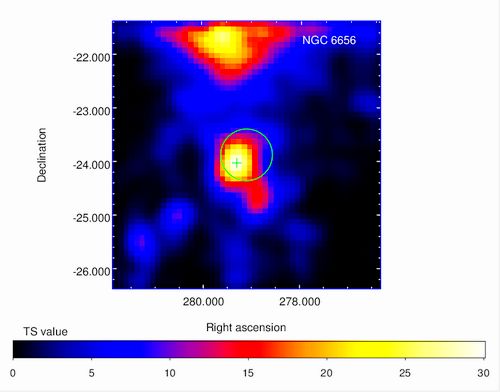Globular clusters (GCs) are the oldest and most dense stellar systems in the Galaxy. The dynamical interactions with high stellar encounter rate are expected to form low-mass X-ray binaries (LMXBs). Millisecond pulsars (MSPs) are generally believed to be the descendants of LMXBs. It is also widely accepted that MSPs contribute almost all gamma ray emissions of GCs. There is already 9 GCs have been associated with gamma ray emitters. By analysing more than 6 years survey data of Fermi-LAT, we confirm the significant gamma ray emission from 2MS-GC01 and IC 1257, and report the discovery for gamma ray emission from NGC 5904 and NGC 6656 within their tidal radii. An strong evidence of significant gamma ray emission is found from FSR 1735.

Figure 1. TS maps of the ROIs for NGC 5904, NGC 6656 and FSR 1735. The cross represents the best-fitting centroid of their γ-ray emission. Thecircles represent the tidal radii (Harris 1996, 2003 version). The tidal radius of FSR 1735 is unknown.
The above figures represent TS maps of ROI (region of interest) from NGC 5904 and NGC 6656. The cross represent the best-fit centriod of the gamma ray emission from them, while the circle for the tidal radius. We estimate the population of MSPs in each GC, which is larger than the number of known. It may be limited by the sensitivity of existing radio telescopes. This work is done by Jianeng Zhou of Purple Mountain Observatory who is collaborated with Pengfei Zhang, Xiaoyuan Huang, Xiang Li, Yunfeng Liang, Lei Fu, Jingzhi Yan and Qingzhong Liu, which is accepted by MNRAS and available at http://mnras.oxfordjournals.org/content/448/4/3215.full.pdf
